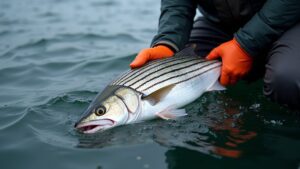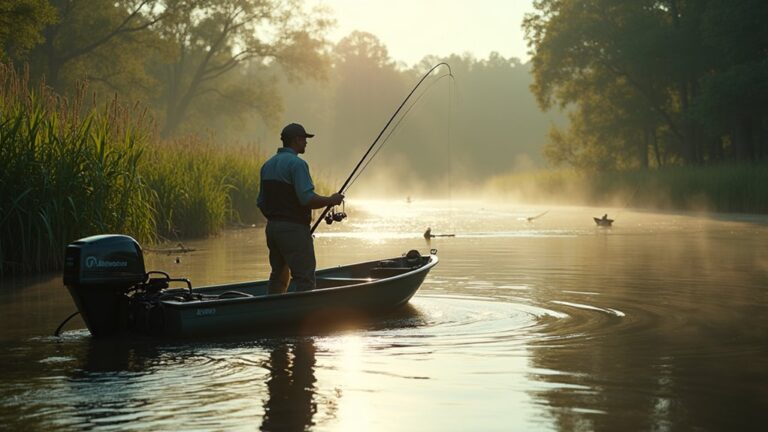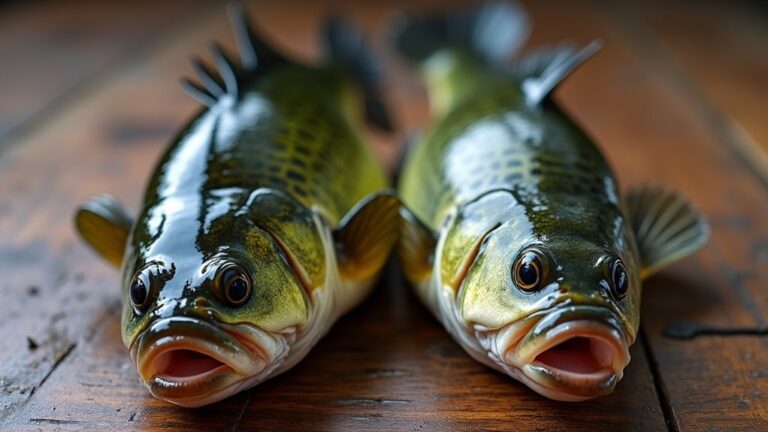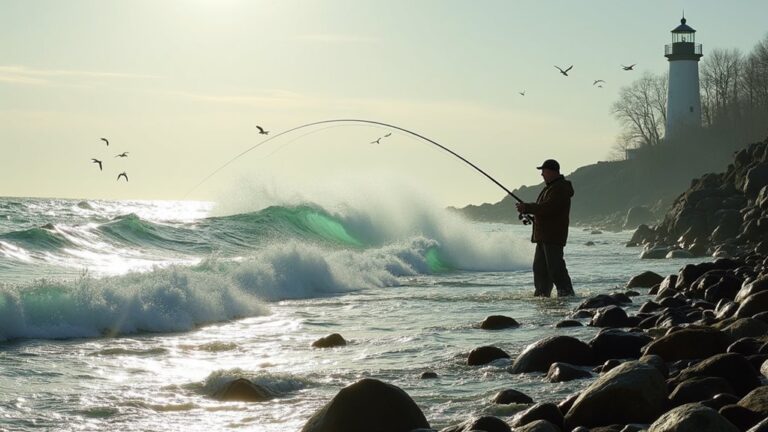You’ll find striped bass on shallow flats, tidal rivers and edges at low-light; use twitch‑sink topwater and softbaits. Bluefish hit fast, noisy presentations and need stout rods and heavy leaders. Fluke hang on sandy edges and troughs—slow hops on 1/2–1 oz heads work best. Offshore, cod, haddock and pollock take jigs over wrecks and ledges. Learn tides, structure and tackle choices to match each species and improve your hookups as you go.
Important Takeaways
- Striped bass: target tidal flats and shoreline structure from April to October, focusing low-light periods with topwater and twitch-retrieval soft baits.
- Fluke (summer flounder): fish sandy flats, troughs, and edges with light tackle, 1/2–1 oz leadheads, and slow hops along the bottom.
- Cod and haddock: use heavier offshore tackle and jig or bait over wrecks and ledges, varying cadence from vertical drops to aggressive lifts.
- Read tides and structure: follow incoming/outgoing flows, bait schools, depth changes, and channel edges to locate predator feeding zones.
- Gear and leaders: match tackle to species—light braid/fluoro for fluke, stout rods and abrasion-resistant or wire leaders for bluefish and cod.
Striped Bass: Behavior, Seasons, and Top Spots
Wondering where to find the biggest action? You’ll target striped bass from mid-April to October, focusing on shallow flats and tidal rivers with light to medium tackle. You’ll fish low-light periods—pre-dawn, sunrise, dusk, and night—when ambush behavior makes them more willing to strike. For soft-bait tactics, rig YUM Break’N Shad or YUM Pulse on 1/2- to 3/4-ounce leadheads and use a twitch-sink-twitch cadence to match silhouette feeding. Structure matters: docks, sodbanks, inlet rocks, channel edges, and piers rank among the top spots where bass stage as light changes. You can also try surface plugs—Creek Chub Knuckle-Head poppers and Bomber stickbaits—when fish are active near the surface. Many anglers pair these tactics with realistic topwater lures like the Lunkerhunt Lunker Frog for weedless presentations in heavy cover and near shoreline structure, especially when targeting bass in weedy flats and backwaters with weedless topwater frogs.
Bluefish: Aggressive Feeders and Best Tactics
After you pull away from the flats where stripers wait in ambush, pick a different rhythm for bluefish—these scrappers hit anything that makes a ruckus. You’ll find them at any tide or time, tearing into bait or cleaning dead offerings on the bottom. Use aggressive presentations: quick rod-tip snaps, gurgling retrieves, and topwater poppers to trigger explosive strikes. In late spring expect true gators; summer brings lots of 2–4 pound fighters. Choose stout gear to handle hard hits and toothy jaws, and favor proven lures like Creek Chub Striper Strike and Rebel Magnum Pop-R.
- Fish fast, noisy retrieves
- Throw poppers near shallow structure
- Snap the rod tip for gurgles
- Use heavy leaders for teeth
- Target any tide or daylight
Always wear a properly fitting PFD while fishing from a kayak to stay safe on the water.
Fluke (Summer Flounder): Gear, Rigs, and Hot Techniques
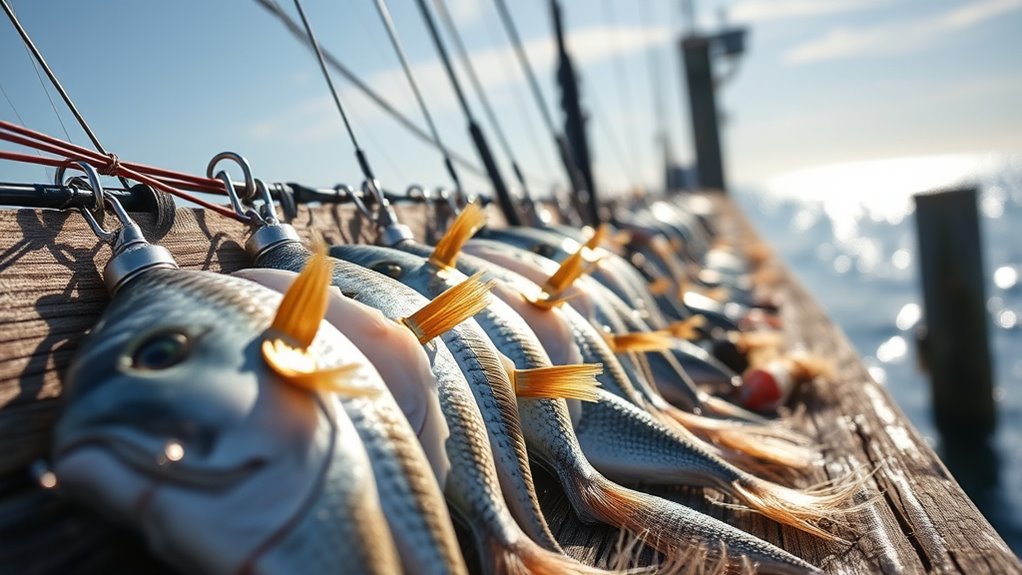
Fluke—also called summer flounder—are a must-target for anglers who like light, sand‑hugging tactics; they feed on sunny days and sit tight on sandy flats, channel edges, wrecks, and dock drop‑offs waiting for a 4–5 inch soft bait to pass overhead. You’ll fish light spinning gear with 10–20 lb braid and a 2–4 ft fluorocarbon leader. Rig 1/2–1 oz leadheads with 4–5 inch soft baits that mimic bait fish profiles. Try a teaser rig: a 2/0–3/0 bucktail teaser about 18 inches above the soft bait to trigger follows. Work slow hops or a subtle drag along the bottom, watching for gentle taps. Focus channels, troughs, sandy flats, and structure edges where fluke hold. For extended days on the water, consider sun-protective performance shirts with UPF 50+ to stay comfortable and shielded.
Cod, Haddock, and Pollock: Offshore Bottom Strategies
When you move offshore from the sand flats where fluke hold, you’ll need heavier tackle and a different game plan to chase Cod, Haddock, and Pollock over wrecks, ledges, and hard bottom. You’ll focus on offshore bottom structure, using heavy rods, big reels, and sturdy lines to punch down and hold bottom. Jigging metal lures over wrecks and rocky contours helps cover water and trigger strikes; Pollock may require more patient vertical drops while Cod and Haddock respond to aggressive lifts. Read bottom contours, mark wrecks, and vary cadence until you find what works. Safety and gear durability matter on pelagic bottom runs. Match line strength and abrasion-resistant leaders to target species and structure, prioritizing abrasion resistance for durability.
- Use heavy rods and large offshore reels
- Mark wrecks and ledges with your sounder
- Vary jigging cadence and retrieve speed
- Trust jigging metal lures for deep bites
- Keep abrasion-resistant leaders and hooks
Black Sea Bass and Tautog: Structure Fishing and Baits
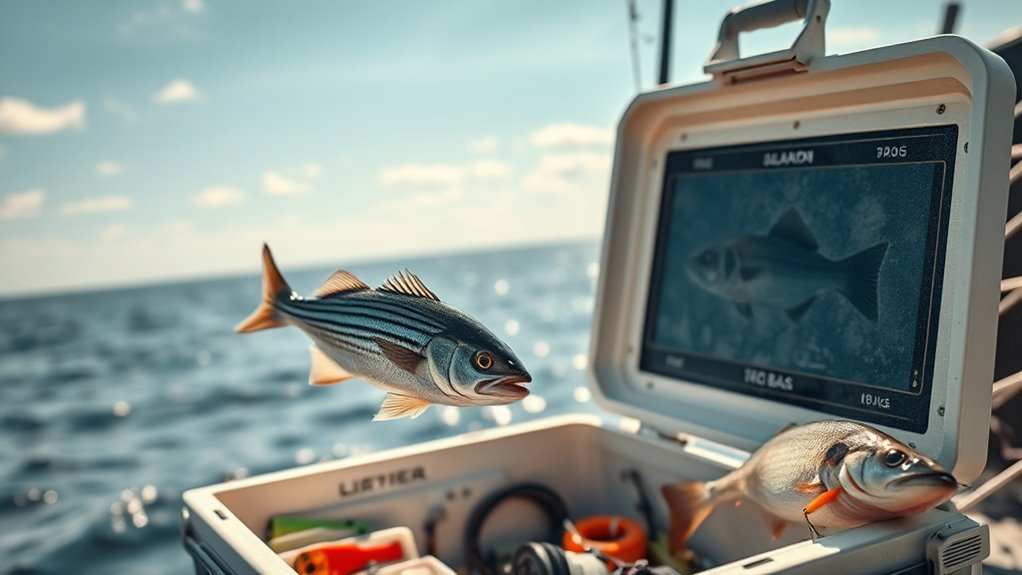
If you’re targeting structure in the Northeast, Black Sea Bass and tautog demand a different approach than sand-flat fluke: both hang tight to rock, wrecks, and reefs, so you’ll want to present baits and jigs accurately, watch tides and thermoclines, and be ready for sudden depth changes.
You’ll focus on structure fishing around Cape Cod, Buzzards Bay, and Rhode Island borders where both species concentrate.
Use medium-action tackle for tautog with crabs, clams, or shellfish baits fished slow and precise.
For sea bass, fish around rocky banks with jigs or cut bait, and be prepared to follow depth shifts as tides and temperatures move fish.
Check seasonal closures and size limits before you head out.
Gravel beds and spawning sites in nearby estuaries can also indicate productive structure zones where baitfish and juvenile fish aggregate.
Weakfish and Nighttime Ambush Tactics
Moving off rocky structure and into the quieter edges of estuaries and tidal rips, you’ll find weakfish staging for their nocturnal ambushes—these secretive predators come alive at dawn, dusk, and during the darkest hours. You’ll want stealth: subdued retrieve speeds, low-profile boats, and muted line noise to trigger nighttime ambush tactics. Rely on silhouettes and subtle action rather than flash. For smaller tiderunners use lighter presentations; for bigger fish switch to larger plugs and single hooks to improve hooksets. Watch current seams and moonlit channels where bait concentrates. Fish quietly along edges and drop-offs
- Use soft profiles that silhouette well
- Match presentation weight to tide and size
- Prefer single hooks on larger plugs
- Focus on low-noise retrievals
The Chesapeake Bay mouth is a hotspot for large striped bass and rockfish that follow similar tidal bait concentrations.
Best Lures and Soft Baits for Inshore Predators
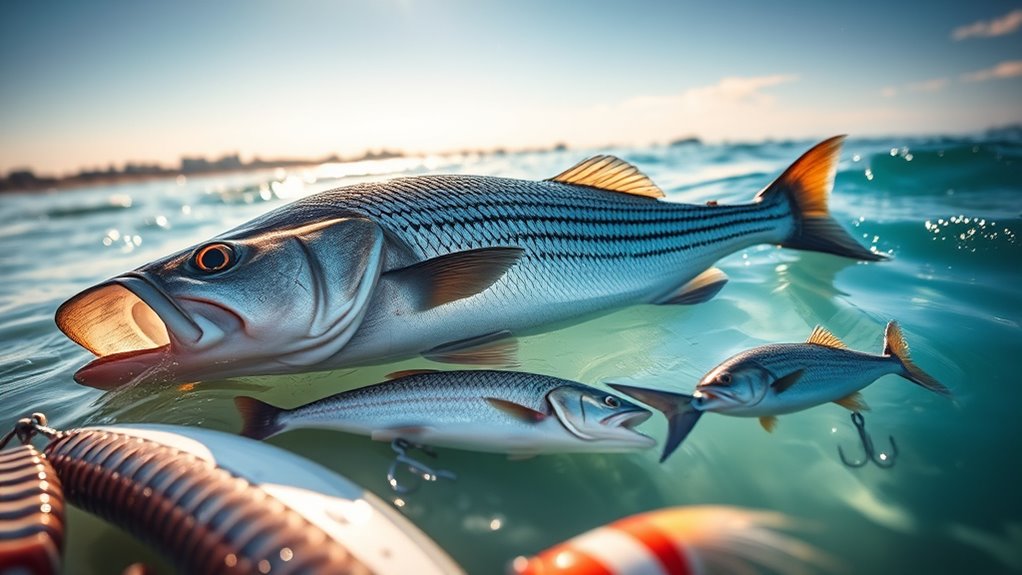
Looking for lures that actually trigger bites inshore? You’ll want soft baits like YUM Break’N Shad and YUM Pulse on 1/2–3/4 oz leadheads for striped bass and bluefish in low light or high-activity periods. Use a twitch-sink-twitch retrieve to silhouette-target bass near docks, sodbanks, inlet rocks, channel edges, and piers. Larger plugs such as Bomber Magnum Long A or Badonk-A-Donk worked with soft baits help with bigger tiderunners or nighttime targets and improve hook angles. Poppers and surface commotion lures still coax bluefish from shallow flats at dawn and dusk. Focus casts around structure, vary cadence, and match bait size to current and target species to convert follows into solid hookups. Fish during low light conditions to increase feeding activity and hookups.
| Lure Type | Best Use | Tip |
|---|---|---|
| Soft baits | Low light structure | Twitch-sink-twitch |
| Plugs | Big tides/night | Pair with soft bait |
Topwater and Low-Light Presentation Strategies
You’ve already seen how soft baits and larger plugs win bites in low-light and high-activity windows — now focus on making those offerings read as live prey on the surface. You’ll favor topwater poppers and stickbaits at dawn, dusk, and night where stripes ambush from docks, sodbanks, and channel edges. Use a twitch-sink-twitch cadence with soft plastics to mimic struggling bait, prioritize high-contrast colors for visibility in low-light, and employ sensitive rods and braided lines to feel subtle taps. Cast ahead of likely ambush points and pause to let bass commit.
- Choose poppers like Creek Chub Knuckle-Head for noisy surface commotion
- Work stickbaits with steady twitches and occasional pauses
- Match contrast to ambient light
- Use light leaders and sensitive gear
- Cast beyond target structure and retrieve into it
Tides, Structure, and Reading Feeding Zones
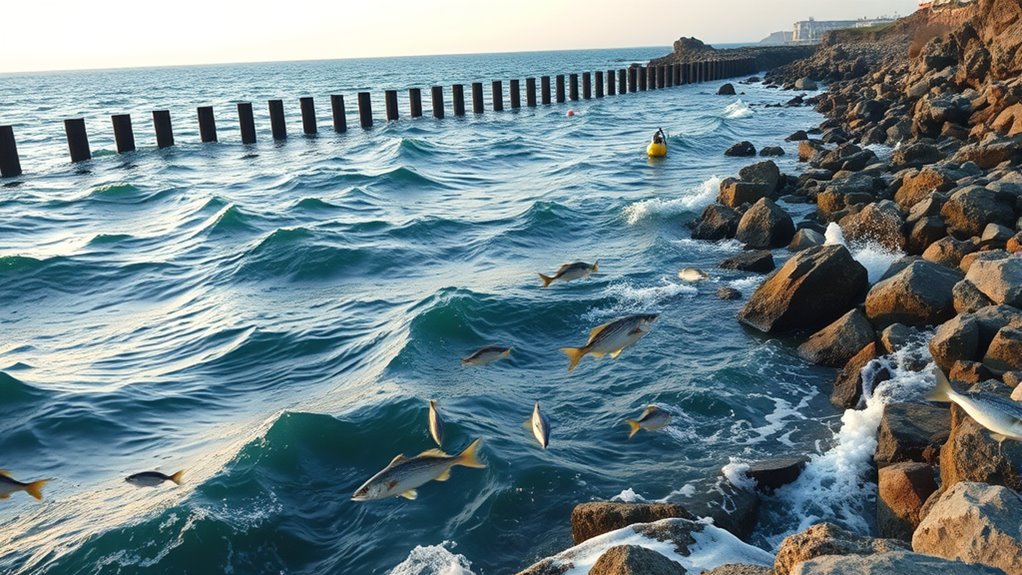
When will fish concentrate where you can reach them? You watch tidal exchange and current to find bite windows: incoming and outgoing flows move bait along docks, sodbanks, and channel edges where predators patrol. Structure—piers, ledges, rock walls—funnels prey and creates ambush points for bass, fluke, and bluefish. Read feeding zones by noting bait schools, depth changes, and bottom contours; shallow flats hold striped bass at dawn and dusk, while deeper edges work as light increases. Bluefish hit commotion near beaches, jetties, and inlet mouths. Cast to channel cuts and seams where current rips meet slack. Below is a simple view of features, flow, and likely species. A reliable reel with long-distance casting capability helps you place presentations precisely where predators concentrate.
| Feature | Flow | Species |
|---|---|---|
| Flats | Light tidal | Striped bass |
| Edges | Strong current | Fluke |
| Jetties | Turbulent | Bluefish |
Gear, Leaders, and Rigging Tips for Tough Fighters
How do you gear up for a fish that hits hard and runs fast? Pick heavy rods and reels matched to target species—striper, bluefish, cod, or offshore pelagics—so you control runs and dives. Prioritize abrasion-resistant mainlines and leaders; bluefish need wire or heavy fluoro leaders to prevent bite-offs. Rigging should favor quick, aggressive presentations—topwater poppers, fast-twitch soft plastics—to provoke explosive strikes. Match tackle and leader strength to conditions and feeding zones to balance hookup rates and durability.
- Use stout rods and high-capacity reels for offshore runs and big cod or tuna.
- Carry wire and heavy fluorocarbon leaders for bluefish.
- Set up quick-change rigs for varying presentations.
- Choose lures to match bite speed and water clarity.
- Test knots and leader-to-line connections regularly.
Also, ensure you are following local regulations and have a valid fishing license before heading out.
Final Thoughts
You’ve got the knowledge to target Northeast saltwater species like striped bass, fluke, cod, and more—now get out there and fish. Match your gear, rigs, and baits to the species and conditions, read tides and structure, and adjust presentations for light and time of day. Stay flexible, use topwater and soft baits when appropriate, and sharpen techniques for tough fighters. Practice, patience, and local scouting will turn tips into consistent catches.

